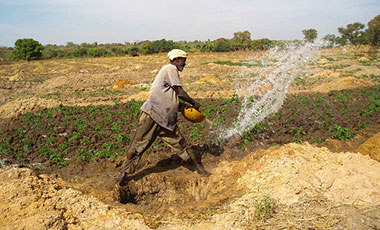The following blog story was written by Laia Domènech, visiting fellow in the Environment and Production Technology Division at IFPRI, in honor of World Water Day 2015. The theme of this year’s event on March 22 is “Water for Sustainable Development.”
A set of 17 Sustainable Development Goals (SDGs) are expected to be adopted in September 2015 by the UN General Assembly. In advancing the 2015 Millennium Development Goals, the SDGs call for action from both developing and developed countries to end hunger, achieve food security and improved nutrition, and promote sustainable agriculture (SDG2) as well as promote sustainable water management (SDG6). Although SDG2 and SDG6 are not linked in the current post-2015 development agenda framework, multiple benefits might be achieved and tradeoffs reduced if both water supply and agricultural water are managed in direct support of improved nutrition, particularly in chronically food-insecure countries and in Africa south of the Sahara.
Globally, an estimated 805 million people are chronically undernourished, many of them in Africa south of the Sahara (SSA), where 329 million also lack access to improved water supply and 640 million do not have access to an improved sanitation facility. The linkages between water, sanitation, and hygiene (WASH) and nutrition have long been recognized. Poor WASH is considered a leading cause of diarrhea, nematode infections, and other conditions such as environmental enteropathy, which is caused by frequent intestinal infections and has received renewed attention in recent years.
Water is also an essential resource for growing food, and water scarcity is a major limiting factor for crop and livestock production in many parts of the world, where rainfall is scarce or erratic. There is great potential to expand small-scale irrigation in SSA, as only 6 percent of the cultivated area in the region is currently irrigated. Rain-fed cereal crops such as maize, sorghum, or millet and roots and tubers are key staples for many households in SSA. Yet these crops have limited nutritional and market value, and their potential to improve nutrition is therefore limited. In contrast, irrigated agriculture is frequently used to grow nutritious vegetables and fruits throughout the year, with important nutritional and health benefits for consumers. The nutritional and food security benefits of small-scale irrigation, however, are rarely recognized in many nutrition-sensitive interventions.
A recent IFPRI Discussion Paper, “Is Reliable Water Access the Solution to Undernutrition? A Review of the Potential of Irrigation to Solve Nutrition and Gender Gaps in Africa South of the Sahara”, identifies four main impact pathways linking irrigation to positive nutrition and health outcomes:
- Irrigation as a source of more diverse foods (through increased agricultural productivity and crop diversification);
- Irrigation as a source of income (from market sales and employment generation);
- Irrigation as a source of water supply, sanitation, and hygiene (through multiple water use), and
- Irrigation as an entry point for women’s empowerment (through increased asset ownership and control over resources and reduced time spent on water collection).
Several risks and undesired outcomes of irrigation, such as new vector-breeding habitats and water pollution from an increased use of agrochemicals, are also examined in the paper.
To date, there is insufficient evidence to link small-scale irrigation with nutrition improvements, suggesting that more analysis is needed to understand how water can support nutrition beyond WASH interventions. However, six steps might help improve nutrition-sensitivity of irrigation development:
- Food security and nutrition gains should be stated goals of irrigation programs;
- Training programs and awareness campaigns should accompany irrigation interventions to promote nutrient-dense food production and consumption as well as minimization of health risks;
- Multiple uses of irrigation water should be recognized in order to enhance uses for water supply and sanitation, livestock and aquatic production;
- Women’s empowerment and women’s participation in irrigation programs should be promoted;
- Homestead food production should be encouraged; and
- Policy synergies between different sectors (agriculture, nutrition, health, water supply and sanitation, and education) should be sought, such as by linking SDG6 on water with SDG2 on hunger, nutrition, and agriculture.
Incorporating nutritional, health, and gender considerations into the design of new irrigation programs and policies would be an important step toward realizing the full potential of irrigation interventions for improved nutrition and human development.







